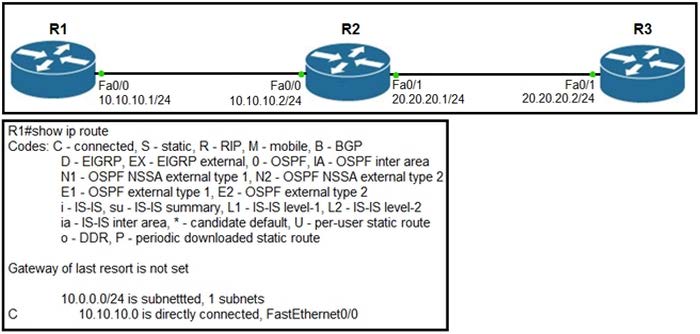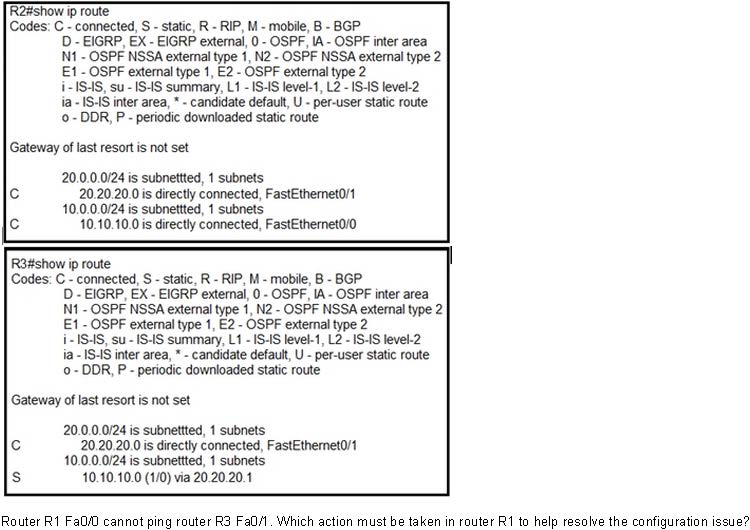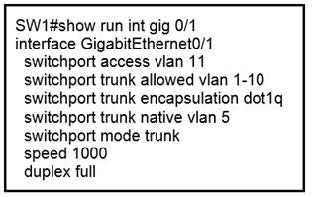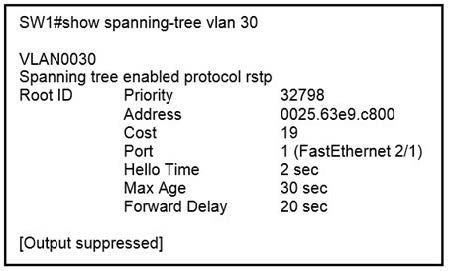Exam Details
Exam Code
:200-301Exam Name
:Implementing and Administering Cisco Solutions (CCNA) (Include Newest Simulation Labs)Certification
:CCNAVendor
:CiscoTotal Questions
:1615 Q&AsLast Updated
:Jun 21, 2025
Cisco CCNA 200-301 Questions & Answers
-
Question 1141:
What is a difference between local AP mode and FlexConnect AP mode?
A. Local AP mode creates two CAPWAP tunnels per AP to the WLC
B. Local AP mode causes the AP to behave as if it were an autonomous AP
C. FlexConnect AP mode fails to function if the AP loses connectivity with the WLC
D. FlexConnect AP mode bridges the traffic from the AP to the WLC when local switching is configured
-
Question 1142:
Refer to the exhibit. Which configuration issue is preventing the OSPF neighbor from being established between the two routers?

A. R1 has an incorrect network command for interface Gi1/0.
B. R2 should have its network command in area 1.
C. R1 interface Gi1/0 has a larger MTU size.
D. R2 is using the passive-interface default command.
-
Question 1143:
Refer to the exhibit. Router R1 is running three different routing protocols. Which route characteristic is used by the router to forward the packet that it receives for destination IP 172.16.32.1?

A. longest prefix
B. administrative distance
C. cost
D. metric
-
Question 1144:
Refer to the exhibit.


Router R1 Fa0/0 cannot ping router R3 Fa0/1. Which action must be taken in router R1 to help resolve the configuration issue?
A. set the default gateway as 20.20.20.2
B. configure a static route with Fa0/1 as the egress interface to reach the 20.20.2.0/24 network
C. configure a static route with 10.10.10.2 as the next hop to reach the 20.20.20.0/24 network
D. set the default network as 20.20.20.0/24
-
Question 1145:
By default, how does EIGRP determine the metric of a route for the routing table?
A. It uses the bandwidth and delay values of the path to calculate the route metric.
B. It uses a default metric of 10 for all routes that are learned by the router.
C. It counts the number of hops between the receiving and destination routers and uses that value as the metric.
D. It uses a reference bandwidth and the actual bandwidth of the connected link to calculate the route metric.
-
Question 1146:
Router R1 must send all traffic without a matching routing-table entry to 192.168.1.1. Which configuration accomplishes this task?
A. R1#Config t R1(config)#ip routing R1(config)#ip route default-route 192.168.1.1
B. R1#Config t R1(config)#ip routing R1(config)#ip route 192.168.1.1 0.0.0.0 0.0.0.0
C. R1#Config t R1(config)#ip routing R1(config)#ip route 0.0.0.0 0.0.0.0 192.168.1.1
D. R1#Config t R1(config)#ip routing R1(config)#ip default-gateway 192.168.1.1
-
Question 1147:
A packet is destined for 10.10.1.22. Which static route does the router choose to forward the packet?
A. ip route 10.10.1.0 255.255.255.240 10.10.255.1
B. ip route 10.10.1.20 255.255.255.252 10.10.255.1
C. ip route 10.10.1.16 255.255.255.252 10.10.255.1
D. ip route 10.10.1.20 255.255.255.254 10.10.255.1
-
Question 1148:
Refer to the exhibit.

An administrator is tasked with configuring a voice VLAN. What is the expected outcome when a Cisco phone is connected to the GigabitEthernet 3/1/4 port on a switch?
A. The phone and a workstation that is connected to the phone do not have VLAN connectivity.
B. The phone sends and receives data in VLAN 50, but a workstation connected to the phone sends and receives data in VLAN 1.
C. The phone sends and receives data in VLAN 50, but a workstation connected to the phone has no VLAN connected.
D. The phone and a workstation that is connected to the phone send and receive data in VLAN 50.
-
Question 1149:
Refer to the exhibit.

Which action is expected from SW1 when the untagged frame is received on the GigabitEthernet0/1 interface?
A. The frame is processed in VLAN 1
B. The frame is processed in VLAN 11
C. The frame is processed in VLAN 5
D. The frame is dropped
-
Question 1150:
Refer to the exhibit.

What two conclusions should be made about this configuration? (Choose two.)
A. The root port is FastEthernet 2/1
B. The designated port is FastEthernet 2/1
C. The spanning-tree mode is PVST+
D. This is a root bridge
E. The spanning-tree mode is Rapid PVST+
Tips on How to Prepare for the Exams
Nowadays, the certification exams become more and more important and required by more and more enterprises when applying for a job. But how to prepare for the exam effectively? How to prepare for the exam in a short time with less efforts? How to get a ideal result and how to find the most reliable resources? Here on Vcedump.com, you will find all the answers. Vcedump.com provide not only Cisco exam questions, answers and explanations but also complete assistance on your exam preparation and certification application. If you are confused on your 200-301 exam preparations and Cisco certification application, do not hesitate to visit our Vcedump.com to find your solutions here.